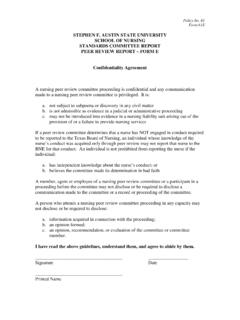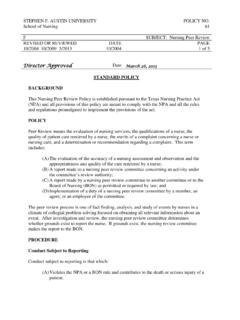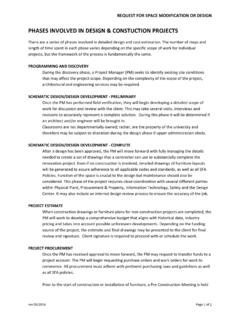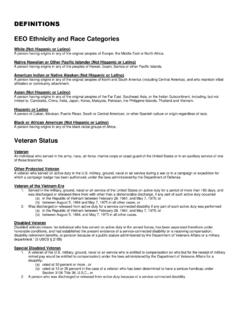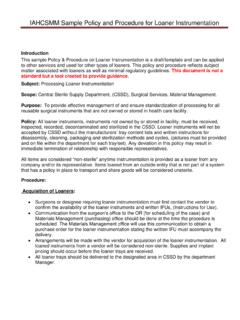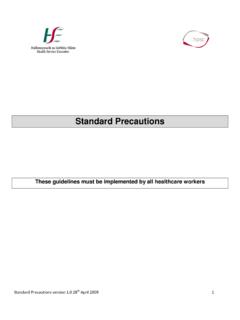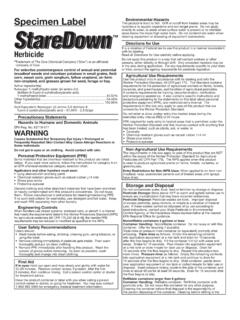Transcription of Decontamination: Standard Operating Procedure
1 decontamination : Standard Operating Procedure This Procedure should be followed in the event of an emergency where a victim or equipment should need to be decontaminated due to a chemical, biological, or radioactive release or spill. When planning to decontaminate in a medical emergency, procedures should be followed to ensure: decontamination of the victim. Protection of medical personnel. Disposing of contaminated protective equipment and wash solutions. The decision whether or not to decontaminate a victim is based on the type and severity of the illness or injury and the nature of the contaminant. For some emergency victims, immediate decontamination may be an essential part of life-saving first aid. For others, decontamination may aggravate the injury or delay life-saving treatment. If decontamination does not interfere with essential treatment, it should be performed. If decontamination can be done: Wash, rinse and/or cut off protective clothing and equipment.
2 If decontamination cannot be done: Wrap the victim in blankets, plastic, or rubber to reduce contamination of other personnel. Alert emergency and offsite medical personnel to potential contamination; instruct them about specific decontamination procedures if necessary. Send along site personnel familiar with the incident. Equipment In an emergency, equipment will be necessary to rescue and treat victims, to protect response personnel, and to mitigate hazardous conditions on site ( , to contain hazardous materials or fight fires). Some regular equipment can double for emergency use. Provide safe and unobstructed access for all firefighting and emergency equipment at all times. Consider adopting the following work procedures . For personnel protective equipment: Basic equipment that should be available at any site can be found in Table A on the next page. Special equipment should be obtained depending on the specific types of emergencies that may occur at a particular site and the capabilities of backup offsite personnel.
3 When determining the type and quantity of special equipment, the following factors should be considered: The types of emergencies that may arise. For each emergency, consider a probable and a worst-case scenario. The types of hazards that site personnel may be exposed to and the appropriate containment, mitigative, and protective measures. The capabilities and estimated response times of offsite emergency personnel. The numbers of site personnel who could be victims during an emergency. The probable number of personnel available for response. Table A Onsite Equipment and Supplies for Emergency Response Personal Protection Medical Hazard Mitigation Blankets Antiseptics Spill-containment equipment such as absorbents and oil Personal protective equipment and clothing specialized for known site hazards. Emergency Eye Wash Containers to hold contaminated materials and clothing. Half face respirators and cartridges Emergency Safety Showers Acid and Base Neutralizers Ice Other clean up gear such as chemical resistant shovels Reference books containing scoops etc.
4 Basic first-aid procedures and information on treatment of specific chemical injuries. Stretcher Water in portable containers Persons trained in CPR Medical Treatment/First Aid In emergencies, toxic exposures and hazardous situations that cause injuries and illness will vary from site to site. Medical treatment may range from bandaging of minor cuts and abrasions to life - saving techniques. In many cases, essential medical help may not be immediately available. For this reason, it is vital to train onsite emergency personnel in on-the-spot treatment techniques, to establish and maintain telephone contact with medical experts ( , toxicologists), and to establish liaisons with local hospitals and ambulance services. When designing this program, these essential points should be included: Train personnel in emergency treatment such as first aid and CPR. Training should be thorough, frequently repeated, and geared to site-specific hazards.
5 Establish liaison with local medical personnel, for example: 24-hour-on-call physician, medical service, and poison control center. Inform and educate these personnel about site-specific hazards so that they can be optimally helpful if an emergency occurs. Develop procedures for contacting them; familiarize all on-site emergency personnel with these procedures . Set up onsite emergency first-aid stations; see that they are well supplied and restocked immediately after each emergency. Emergency Response procedures Response operations usually follow a sequence that starts with the notification of trouble and continue through the preparation of equipment and personnel for the next emergency. Notification Alert personnel to the emergency. Sound a site alarm to: Notify personnel. Stop work activities if necessary. Lower background noise in order to speed communication. Begin emergency procedures . Notify on-site emergency response personnel about the emergency and include essential information.
6 * What happened? * Where it happened? * Whom it happened to? * When it happened? * How it happened? * The extent of damage. * What aid is needed? Size Up Available information about the incident and emergency response capabilities should be evaluated. The following information should be determined, to the extent possible: What happened? Type of incident. Cause of incident. Extent of chemical release and transport. Extent of damage to structures, equipment, and terrain. Casualties: 1. Victims (number, location, and condition). 2. Treatment required. 3. Missing personnel. What could happen? Consider: 1. Type of chemicals on site. 2. Potential for fire, explosion, and release of hazardous substances. 3. Location of all personnel on site relative to hazardous areas. 4. Potential for danger to offsite population or environment. What can be done? Consider: 1. Equipment and personnel resources needed for victim rescue and hazard mitigation.
7 2. Number of uninjured personnel available for response. 3. Resources available on site. 4. Resources available from outside groups and agencies. 5. Time for outside resources to reach the site. 6. Hazards involved in rescue and response. Rescue/Response procedures Based on the available information, the type of action required should be decided and the necessary steps implemented. Some actions may be done concurrently. No one should attempt emergency response or rescue until backup personnel and evacuation routes have been identified. Rescue/response actions may include. Enforce the buddy system: Allow no one to enter an Exclusion Zone or hazardous area without a partner. At all times, personnel in the Exclusion Zone should be in line-of-site or communication contact with the Command Post Supervisor or designee. Survey casualties: Locate all victims and assess their condition. Determine resources needed for stabilization and transport.
8 Assess existing and potential hazards to site personnel and to the offsite population. Determine: 1. Whether and how to respond. 2. The need for evacuation of site personnel and offsite population. 3. Resources needed for evacuation and response. Allocate resources: Allocate onsite personnel and equipment to rescue and incident response operations. Request aid: Contact the required offsite personnel or facilities, such as the ambulance, fire department, and police. Control: Bring the hazardous situation under complete temporary control; use measures to prevent the spread of the emergency. Extricate: Remove or assist victims from the area. Decontaminate. Use established procedures to decontaminate uninjured personnel in the Contamination Reduction Zone. If the emergency makes this area unsafe, establish a new decontamination area at an appropriate distance. Decontaminate victims before or after stabilization as their medical condition indicates.
9 Stabilize. Administer any medical procedures that are necessary before the victims can be moved. Stabilize or permanently fix the hazardous condition ( , repack, empty filled runoff dikes). Attend to what caused the emergency and anything ( , drums, tanks) damaged or endangered by the emergency. Transport: Take measures to minimize chemical contamination of the transport vehicle and ambulance and hospital personnel. Adequately protected rescuers should decontaminate the victims before transport. If this is not possible, cover the victims with adequate sheeting. Before transportation, determine the level of protection necessary for transport personnel. Provide them with disposable coveralls, disposable gloves, and supplied air, as necessary, for their protection. If appropriate, have response personnel accompany victims to the medical facility to advise on decontamination . Evacuate: Move site personnel to a safe distance upwind of the incident.
10 Monitor the incident for significant changes. The hazards may diminish, permitting personnel to reenter the site, or increase and require public evacuation. Inform public safety personnel when there is a potential or actual need to evacuate the offsite personnel. Do not attempt a large-scale public evacuation. This is the responsibility of government authorities. Follow Up Before normal site activities are resumed, personnel must be fully prepared and equipped to handle another emergency. Notify appropriate government agencies as required. For example, OSHA must be notified if there have been any fatalities or five or more hospitalizations in an industrial situation. Restock all equipment and supplies. Replace or repair damaged equipment. Clean and refuel equipment for future use. Review and revise all aspects of the Contingency Plan according to new site conditions and lessons learned from the emergency response.
